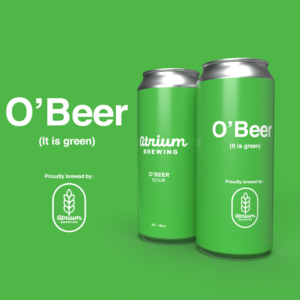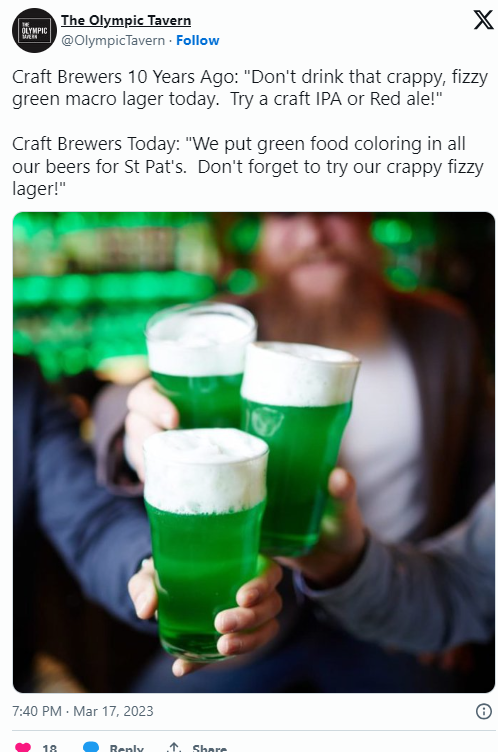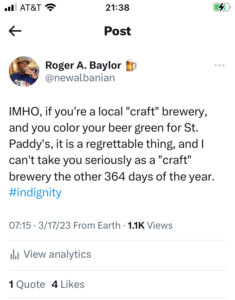 The Spring 2024 issue of Food & Dining Magazine is now available in all the familiar places: Louisville area eateries and food shops, newsstands and online.
The Spring 2024 issue of Food & Dining Magazine is now available in all the familiar places: Louisville area eateries and food shops, newsstands and online.
It’s been a while since I wrote about St. Patrick’s Day entirely from scratch. That’s because my past efforts have always been ripe for quick and easy remixing, thus sparing me the need to squeeze my brain yet again.
In my line of work reruns are absolutely essential, and don’t allow anyone to tell you differently. But maybe it’s time for a (slight) change of pace. Consequently, let’s restart at the beginning, and work our way toward the inevitable greatest hits playlist.
As the DNA evidence suggests, some of me is Irish. The rest of me is English, German and even a bit Swedish, which is probably a legacy of wild Viking oats being sowed amid the British Isles. Of course, my passport is oblivious, plainly asserting that I’m 100% American, but then again, unless one’s heritage is Native American, we Americans all came from somewhere else – voluntarily or otherwise.
It seems we’re all born on the 4th of July, unless it’s time for a “heritage” holiday: Kwanzaa, Chinese New Year, Cinco de Mayo, Oktoberfest, Burns Night – or St. Patrick’s Day. Then we’re eager to share in the experience of past arrivals to our collective aerie of a nation-state, even while clamoring loudly about whatever contemporary immigration situation is currently prompting the most distemper on social media (and in the process, accomplishing nothing in terms of resolving it).
If I’m to be honest, it never made very much sense to me that I’d choose to honor the Irish experience in America (or the Uruguayan, Eritrean or Indonesian) without learning something about the country in question. I readily concede that serious-mindedness is an innate, personalized response, because for me “fun” tends to be neither frivolous nor spontaneous, and certainly not Disneyesque.
Rather, my fun is reality-based, and this brings me to an absurdly tinted St. Patrick’s Day topic that first arose during my college daze, when it was suggested by my friends at the time that we should visit one of the local bars for the express purpose of consuming golden-colored forgettable light lager beer dosed with blue food coloring, thus rendering it green.
I was baffled then, and my reaction is much the same now, 40-odd years later: If you claim to like beer, even wretched beer like Coors Light, then why bastardize, adulterate and desecrate it – and, moreover, aren’t we supposed to be drinking black and red and yellow Irish beers, anyway (i.e., Guinness, Smithwick’s and Harp)?
Them: C’mon, Roger, green beer is fun.
Roger: Nope, in my world it isn’t fun at all.
Serendipitously, in 2023 it transpired that my Food & Dining Magazine colleague Kevin Gibson undertook to explain his own anti-green beer feelings, completely unprompted by me: The Taste Bud: This St. Patrick’s Day, Please Don’t Drink Green Beer.
Being a polemicist by nature, who swears by the late journalist David Brinkley’s axiom “you’re entitled to my opinion,” last year I happily referred my F&D readers to Kevin’s impeccably reasoned essay, then trundled off to my breakfast herring and coffee.
Returning to the agora a bit later, I found that element of the local beer cognoscenti were declaring me public enemy number one for having grievously insulted Atrium Brewing’s purpose-built O’Beer, a sour ale, the prior existence of which was 100% unknown to me.
 O’Beer: A beer that is green. This 7% sour is filled with passion fruit, blue raspberry, lemon, and vanilla. It is also green.
O’Beer: A beer that is green. This 7% sour is filled with passion fruit, blue raspberry, lemon, and vanilla. It is also green.
And I’d also failed to disclose the noble Prussian tradition of adding woodruff syrup to Berliner Weiss, known as Berliner Weiße mit Schuß (“with a shot”), resulting in ale with a greenish tinge.
(Did you know that Berliner Weiße mit Schuß is also the name of a 1984 German television series?)
Of course, from the very outset I made it clear that my target was the practice of artificially coloring golden beer to turn it green, so there shouldn’t have been any confusion, but here we are. It’s the internet, for chrissakes.
Moreover, in all honesty, it never once occurred to me that quite apart from the “greening” of Mich Ultra, that America’s craft brewers — game-changers, revolutionaries and topplers of mass-market swill — had themselves embraced food coloring. You could have felled me with a Donegal feather.

The narrower ramifications of this tempest in a St. Paddy’s Day piss-pot in 2023 proved to be both unexpected and regrettable; so it goes, and I’ve had an entire year to pull myself up from the barroom floor, dust off my tattered lapels, and humbly reconsider my anti-adulteration viewpoint as an impetus for an earnest personal awakening, in which the redemptive script calls for me to see the error of my ways.
(All we need is love, although it occurs to me that adding blue food coloring to the yellow submarine would render it suitably … Irish? Vulgarian? Certainly not Vulcan.)
Consequently, in a spirit of convivial, let-bygones-be-bygones unity, kindly allow me to reveal that (a) I wasn’t at all in error, (b) dyed beer is as ever silly and unnecessary, and (c) I’ll be doubling down on my anti-green beer venom (with the exception of O’Beer and Berliner, naturally), and pointing my readers for a second time to Kevin’s stellar essay:
I dislike the notion of green beer for several reasons. Number one on the list is that this is clearly an American tradition that is trespassing on an Irish religious holiday. I’m not a religious person at all, but Americans have turned St. Patrick’s Day into little more than yet another excuse to drink. I’ve never needed an excuse to drink, nor should anyone. If you want to drink, just do it, and do so responsibly please. (This has been a public service announcement.)
Another reason, and this is a brief aside unrelated to St. Patrick’s Day, is that the term “green beer” brings to my mind a term for beer that isn’t fully fermented, which means it still contains acetaldehyde. And acetaldehyde makes beer taste like unripe apples. No beer should taste like unripe apples.

Let’s face a few facts. Not only am I utterly unable to have “fun” just like ordinary folks, but my stridently Grinch-like demeanor is fairly laced with the sort of heels-dug-in stubbornness that suggests a heritage of Mules, as opposed to Montenegrins – not that there’s anything wrong with either temperamental pack animals or the rowdy Balkans.
Although my guess is that you’d never catch self-respecting Montenegrins adding food coloring to their beers.
Shots of rakija, maybe, and who are we to quibble with brandy consumed neat, sans craft cocktail adornment?
—
Legend holds that in 1962 manager Casey Stengel assembled his New York Mets, to this very day still major league baseball’s worst-ever team, and asked his squad this question: “Can’t anybody here play this game?”
Similarly, with every year’s St. Patrick’s Day bacchanal comes a necessary but probably doomed consideration of proper consonants. In short, if one is prone to abbreviation, it’s St. Paddy’s Day.
Paddy is derived from the Irish, Pádraig: the source of those mysterious, emerald double-Ds. Patty is the diminutive of Patricia, or a burger, and just not something you call a fella. There isn’t a sinner in Ireland that would refer to a Patrick as “Patty”.
And, while we’re at it, get your St. Paddy’s Day toasts right: Sláinte (SLAHN-chə), taken as “good health” in English, and derived from the Gaelic word slán, meaning “healthy” or “safe.”
Also, St. Paddy’s Day offers you the ideal opportunity to leave Miller High Life to the pet shampoo aisle where it truly belongs, and say “Sláinte!” to a pint of Guinness Stout, a longstanding, light-bodied dark ale possessing far fewer calories than you probably imagine it does.
However, if dilution is desired, forget the asinine food coloring and request a half-and-half (Guinness layered with Smithwick’s Red or Harp Lager) rather than a “black & tan,” as the latter term describes infamous, violent paramilitary vigilantes who wreaked havoc during Ireland’s bloody civil war a century ago.
The same respect for the history of others applies to the unfortunately labeled “Irish Car Bomb,” which not unexpectedly was invented right here in learning-deficient America. Boston-based bartender Haley Hamilton explains.
Look, I get it: It’s just a drink. But here’s the thing: Unless you crawled out from under a rock yesterday or have zero working knowledge of either 20th-century European history or the English language, you know it’s at the very least a disservice to the Irish culture you claim to be celebrating on St. Patrick’s Day, if not downright offensive. You wouldn’t order a suicide bomb on the Fourth of July, or a pulse shot during Pride, right? So it is with the Irish car bomb: It’s an insensitive and traumatic reminder of a dark and painful period of Ireland’s national history.
Finally, gleefully reveling in my status as a professional kill-joy, certain aspects of St. Patrick’s Day cuisine also cannot elude closer scrutiny (we’re looking at you, Corned Beef & Cabbage, another Americanism masquerading as Irish).
Now for a pause from my own contrarian task of laying waste to doltishness, we revert to the tried and true: My all-time favorite view of St. Patrick’s Day from the jaundiced service industry worker’s perspective, a commentary originally penned almost a quarter-century ago by a witty East Coast bartender named Chris Halleron for an e-newsletter called “Hot Trub.”
Chris granted me permission to reprint his words in perpetuity, and I’ve been doing so ever since. Some references are dated, but in the main Chris’s commentary has remained remarkably accurate. In the past I’d read it, dissolve into laughter, and resolve to stay safely home throughout the day to avoid the mayhem inflicted by “green-dyed” amateurs.
So it remains in 2024; it’s time to stop dumbing down, and start wising up. Take it away, Chris.
—
Erin Go Blah
Recently a friend asked if I was free to do something on St. Patrick’s Day, but I explained that asking a bartender to take that day off is like asking an accountant to blow off work on April 14.
It is the busy season for bartenders, when we get to see all those cheapskate rookies who haven’t spent a dime in the bar since they threw up in the corner on New Year’s Eve but now decide to poke their heads out of their holes and celebrate the Feast of St. Patrick.
While most people celebrate St. Patrick’s Day on March 17, where I come from it seems to last longer than Mardi Gras in N’Awlins (coincidentally, that’s also taking place right now). Hoboken, New Jersey, where I tend bar, has its parade the first Saturday of March every year, so as not to compete with the mega-parade across the Hudson in Manhattan on the actual St. Patrick’s Day.
Other communities in New Jersey spread their celebrations out in the interim, creating one thick fog of overindulgence week after week until finally the corned beef and cabbage comes out and everybody is too sick to eat it.
Normally I’d be all for such a celebration, but for the fact that somebody has to work these things — and once again that somebody is me. While I’m surely preaching to the choir with this column, I’d like to share some misconceptions and social faux pas regarding St. Patrick’s Day that I’ve had the displeasure of observing over years:
- “Kiss Me I’m Irish” buttons will get you nowhere with the ladies.
- There is no “Official” Beer of St. Patrick’s Day. Despite all its recent financial difficulties, the Catholic Church has yet to seek corporate sponsorship of its saints’ feast days (though it may only be a matter of time…)
- The same goes for “Official” St. Patrick’s Day Headquarters–as if that stinky dive down the street with the broken urinal would actually be the epicenter of the world’s St. Patrick’s Day celebration.
- Just because Mario’s Bar and Grill has a shamrock in the window, it doesn’t necessarily make it an Irish bar.
- In most circles, House of Pain’s “Jump Around” is not considered traditional Irish music.
- Ask any brewer and they’ll tell you — when a beer turns green it’s a BAD thing.
- Killian’s Irish Red is made in Golden, Colorado, not Enniscorthy, Ireland.
- Killarney’s is from St. Louis, Missouri, not Killarney, Ireland (the Killarney’s in question no longer is produced by AB-InBev, and there is a craft brewery in Killarney, Ireland).
- The number-one selling lager in Ireland
is Budweiser(in 2022 it was Heineken; overall, Guinness Stout still dominates). - Guinness is most certainly not a microbrewery (I can’t make this stuff up — I swear I actually heard someone say that once).
- Asking a bartender to put a shamrock on the top of a well-poured Guinness is like asking Da Vinci to put a mustache on the Mona Lisa.
- Not only is the “Irish Car Bomb” (a pint glass half full of Guinness with a shot glass of Bailey’s and Jameson dropped in) an appalling name for a drink, the waste of Guinness and Jameson in some novelty shooter is nothing short of blasphemy. Save the “Boilermakers” for the Milwaukee’s Best and enjoy a quality beverage the way it’s meant to be enjoyed.
- A pint of Guinness takes a while to be poured properly — if you’re in a hurry then order something else.
- Guinness in a plastic cup is a travesty, no matter how busy the bar is.
- The plural of Guinness is Guinness, not Guinnesses.
- More often than not, Irish people (by that, I mean people born and raised in Ireland) couldn’t give a rat’s arse what town your great-great-great-great-great-great-great-great-great-great-grandfather left during the Potato Famine.
- There is no room for a discussion of Irish politics in a crowded bar.
- The stereotype of drunken Irish bar-fighters applies mostly to Irish-Americans.
- The Irish pastime of hurling is not what most people in this country think it means.
- No matter what you may have heard or read, a traditional Irish breakfast DOES NOT consist of a six-pack and a potato.
- No, I’d rather not wear a silly plastic green hat while I’m working, but thanks for the offer.
- There is no “siesta” napping on the bar for St. Patrick’s Day — you have that confused with Cinco de Mayo, which is two months away.
- Just because the bar is open all day and all night doesn’t necessarily mean you have to be there drinking the whole time.
- Just because you gave me a big tip doesn’t give you carte blanche for being an @$$hole!!!
Despite all my bitches, gripes and complaints, I’m well aware that there’s a lot of earning of the green that goes along with the wearing of the green. So it looks like I’ll once again have to “Er-Grin ‘n’ Go Bear-it” as I look forward to the pot o’ gold at the end o’ me rainbow — the long, messy rainbow that it is.
In the meantime, may the road rise to meet the rest o’ ye, and Sláinte … from the bitter bollocks behind the bar.
CH
—
Previously at “Hip Hops”:
Hip Hops: Hew Ainslie, an early New Albany brewer, Scots nationalist and poet



















 Roger Baylor is an entrepreneur, educator, and innovator with 42 years of beer business experience in metropolitan Louisville as a bartender, package store clerk, brewery owner, restaurateur, writer, traveler, polemicist, homebrewing club founder, tour operator and all-purpose contrarian.
Roger Baylor is an entrepreneur, educator, and innovator with 42 years of beer business experience in metropolitan Louisville as a bartender, package store clerk, brewery owner, restaurateur, writer, traveler, polemicist, homebrewing club founder, tour operator and all-purpose contrarian.


